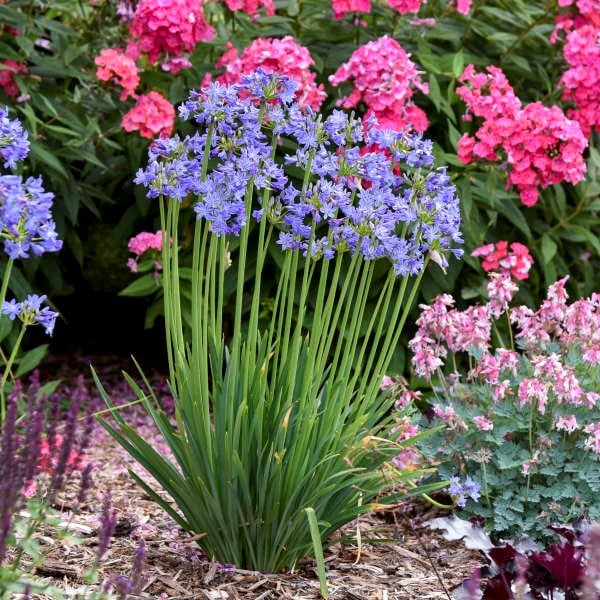Usual Agapanthus Issues and Exactly How to Resolve Them
Usual Agapanthus Issues and Exactly How to Resolve Them
Blog Article
Releasing the Secret to Effective Agapanthus Farming: Advice for a Flourishing Yard
In the world of horticulture, cultivating agapanthus successfully calls for a calculated method that incorporates different facets of plant treatment. By recognizing the nuances of agapanthus cultivation, one can develop an atmosphere where these plants flourish and bloom abundantly.
Planting Agapanthus: Best Practices
When growing Agapanthus, proper dirt preparation is essential for ensuring successful development and development of these attractive blossoms. Agapanthus, typically referred to as Lily of the Nile or African lily, grows in well-draining soil with a somewhat acidic to neutral pH level - Agapanthus. Prior to growing, it is vital to amend hefty clay soils with natural matter such as garden compost or peat moss to improve drain and supply vital nutrients for the plants
To grow Agapanthus, choose an area that receives complete sunlight to partial color, as this will certainly promote healthy development and abundant flowering. Dig an opening two times the diameter of the plant's root round and place the Agapanthus at the exact same depth it was previously expanding. Gently backfill the hole with dirt, weighing down firmly to eliminate any kind of air pockets around the roots.
Water the recently grown Agapanthus extensively and remain to keep the dirt evenly wet, especially throughout the plant's energetic expanding season. Agapanthus. Applying a balanced fertilizer once a month can additionally sustain the plant's development and flowering. By following these finest techniques for growing Agapanthus, you can develop a spectacular display screen of these exciting flowers in your garden
Ideal Soil Conditions for Agapanthus
For optimal development and growing success of Agapanthus plants, guaranteeing the dirt conditions are perfect is vital. Agapanthus flourishes in well-draining soil with a slightly acidic to neutral pH level varying from 6.0 to 7.0. This kind of soil permits ample water drain, preventing waterlogging which can result in root rot. To enhance soil drainage, take into consideration including natural issue such as garden compost or peat moss when preparing the growing website. In addition, Agapanthus likes dirt that is rich in nutrients, so integrating a balanced fertilizer during the growing season can advertise healthy growth and vibrant blooms.

Watering and Feeding Tips
To ensure healthy and balanced growth and vibrant blossoms, correct watering and fertilizing techniques are important for effective Agapanthus growing. Agapanthus plants profit from normal watering, specifically throughout the growing season.
When it involves fertilizing Agapanthus, a balanced plant food with equal components nitrogen, phosphorus, and potassium can be used in the spring to advertise healthy and balanced development and flowering. Slow-release fertilizers are perfect for providing nutrients gradually over an extensive duration. Prevent over-fertilizing, as this can result in excessive vegetation growth at the expenditure of blossoms.
Furthermore, incorporating organic matter like garden compost into the dirt can improve nutrient levels and boost soil structure, assisting in the general health of the Agapanthus plants. By adhering to these watering and feeding tips, garden enthusiasts can ensure their Agapanthus plants grow and produce stunning screens of flowers.
Trimming and Deadheading Techniques
Appropriate pruning and deadheading methods play an essential duty in preserving the wellness and aesthetics of Agapanthus plants, matching the important methods of watering and fertilizing for successful farming. Trimming Agapanthus entails eliminating invested flower heads, yellowing or dead fallen leaves, and overall shaping of the plant to advertise better growth. Deadheading, the procedure of removing faded blossoms, not just enhances the plant's look but also urges further flowering.
When deadheading Agapanthus, it is advisable to snip off the blossom stem at the base making use of sharp, tidy shears. This process redirects the plant's power from seed manufacturing back right into root and foliage development, advertising a healthier and a lot more durable plant. Regular deadheading can extend the flowering duration of Agapanthus and protect against self-seeding, which can result in congestion.
In terms of pruning, Agapanthus generally take advantage of a light trim after flowering to clean the plant and encourage fresh growth. Cutting back the invested blossom stems and getting rid of any kind of dead or broken vegetation aids keep the plant's vitality and general appearance. However, it is important to prevent cutting right into the crown check these guys out of the plant, as this can compromise its health.

Protecting Agapanthus From Pests and Diseases
Carrying out effective insect and condition administration techniques is essential to guarding the health and vigor of Agapanthus plants in cultivation. One typical parasite that impacts Agapanthus is the Agapanthus borer, a caterpillar that passages into the plant, triggering damages to the blossoms and fallen leaves.
In addition to insects, Agapanthus are prone to diseases such as origin rot and fungal leaf areas. By remaining cautious and resolving pest and disease concerns promptly, garden enthusiasts can assist their Agapanthus grow and prosper.

Conclusion
To conclude, successful farming of agapanthus requires appropriate planting methods, optimal dirt problems, appropriate watering and fertilizing, routine trimming and deadheading, and protection other from bugs and conditions. By following these ideas and techniques, garden enthusiasts can ensure a growing yard loaded with stunning agapanthus blossoms. Agapanthus. Remember to keep consistent care and interest to information to advertise the health and longevity of these sensational plants
When growing Agapanthus, correct dirt prep work is important for making sure effective development and growth of these gorgeous flowers.Water the recently planted Agapanthus extensively and proceed to keep the dirt equally wet, specifically throughout the plant's energetic expanding period.For optimal growth and growing success of Agapanthus plants, ensuring the dirt conditions are ideal is important. When growing or hair transplanting Agapanthus, make sure the soil is well-prepared to supply the essential structure for the plants to develop themselves effectively. One typical insect that affects Agapanthus is useful content the Agapanthus borer, a caterpillar that tunnels right into the plant, creating damages to the fallen leaves and flowers.
Report this page